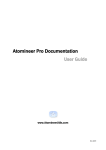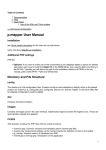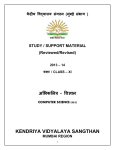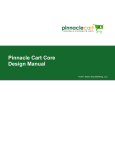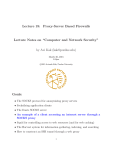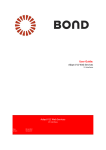Download pdf version - ShnfuCarver 1.0 documentation
Transcript
ShnfuCarver Documentation
Release 1.0
Little Tiger
March 15, 2012
CONTENTS
1
Coding Standards
1.1 PHP Coding Standards . . . . . . . . . . . . . . . . . . . . . . . . . . . . . . . . . . . . . . . . . .
1.2 ShnfuCarver Coding Standards . . . . . . . . . . . . . . . . . . . . . . . . . . . . . . . . . . . . .
3
3
11
2
Development Environment and Tools
2.1 Development Environment . . . . . . . . . . . . . . . . . . . . . . . . . . . . . . . . . . . . . . . .
2.2 Development Tools . . . . . . . . . . . . . . . . . . . . . . . . . . . . . . . . . . . . . . . . . . . .
13
13
13
3
ShnfuCarver Design
3.1 Framework Architecture
3.2 Kernel Architecture . .
3.3 Framework Components
3.4 Application Hierarchy .
15
15
16
17
20
.
.
.
.
.
.
.
.
.
.
.
.
.
.
.
.
.
.
.
.
.
.
.
.
.
.
.
.
.
.
.
.
.
.
.
.
.
.
.
.
.
.
.
.
.
.
.
.
.
.
.
.
.
.
.
.
.
.
.
.
.
.
.
.
.
.
.
.
.
.
.
.
.
.
.
.
.
.
.
.
.
.
.
.
.
.
.
.
.
.
.
.
.
.
.
.
.
.
.
.
.
.
.
.
.
.
.
.
.
.
.
.
.
.
.
.
.
.
.
.
.
.
.
.
.
.
.
.
.
.
.
.
.
.
.
.
.
.
.
.
.
.
.
.
.
.
.
.
.
.
.
.
.
.
.
.
.
.
.
.
.
.
.
.
4
Shnfu Design
23
5
About Documentation
5.1 Documentation formatting guide . . . . . . . . . . . . . . . . . . . . . . . . . . . . . . . . . . . . .
25
25
6
Indices and Tables
31
Index
33
i
ii
ShnfuCarver Documentation, Release 1.0
This is the design documentation of ShnfuCarver framework, the guide for the whole framework development.
Developers should read this before coding. There is also a pdf version . This documentation could be revised if there
is any good suggestion.
CONTENTS
1
ShnfuCarver Documentation, Release 1.0
2
CONTENTS
CHAPTER
ONE
CODING STANDARDS
1.1 PHP Coding Standards
Developers should always keep in mind all items listed in this chapter. These are the basic conventions for all the PHP
coding.
1.1.1 Quick Style Overview
This is an example which includes some of the standards in this chapter. It does not include everything but developers
could have a straightforward impression of what will be described in detail in the following sections.
TODO: Write a full example for these coding standards.
<?php
?>
1.1.2 File Format
Use UTF-8 character encoding for the codes.
Lines must end only with a line feed (LF). Do not use carriage returns (CR) like Macintosh OS do or the carriage
return/line feed combination (CRLF) like Windows OS does.
There should be one line feed after the closing PHP tag (?>) at the end of file. Vim would do this automatically and
there is no need for adding an extra line.
1.1.3 Coding Style
• No spaces on a blank line.
• No trailing spaces at the end of line.
• No extra blank line at the end of file.
• Add proper blank line to separate different logic.
• Break a long line into several short lines. It is recommended that lines should be no more than 80 columns. This
could increase the readability, as 80 is just the length of lines in old text mode.
• Only English character is allowed in the code, including the comments, except for the localization strings.
• Align assignment and parameters in function call when possible:
3
ShnfuCarver Documentation, Release 1.0
<?php
$result
= $this->callSomeFunction
(’param1’,
’second’,
true );
$second_result = $this->callSomeOtherFunction(’parameter2’, ’third’,
false);
$last_result
= $this->callSomeFunction
(’3’,
’verrrrrrylong’, true );
?>
1.1.4 Coding Method
• Always use long tags <?php ?> instead of short tags <?
?>.
• Perl/shell style comments (#) are discouraged.
• The constructor should mainly include class initialization. Do not put in too much action.
• Do not use PHP code (e.g. echo or print) to output the html tag.
• Use === instead of == if possible.
• Do not use magic numbers.
• Do not do exact comparison between float numbers.
• Avoid embedded assignment. This could lead to misunderstanding.
• Use single quotes ’ for strings if no variable expansion.
• Put each class in a single file.
• Use namespace for clear naming, especially for library.
• Try not to create global variables, which may enhance the relation of modules and introduce unexpected behavior.
• Do not use parentheses for statements. (require_once, include, echo, return...)
• Code must be E_STRICT-compatible. This means that it must not produce any warnings or errors when PHP’s
error reporting level is set to E_ALL | E_STRICT (or E_ALL in PHP 5.4.x).
1.1.5 Including Files
When unconditionally including a class or library file, use require_once. When conditionally including a class
file (for example, factory methods), use include_once.
Either of these will ensure that class files are included only once. They share the same file list, so a file included by
require_once will not be included again by include_once.
1.1.6 Comment
A good program should be understood even without comments. But proper comments could make the reading easier.
You do not need to write comments everywhere in the code if the code is in good style. The comment should appear
in the following situation:
1. Some complicated algorithm.
2. Where misunderstanding could happen.
3. Some tricks that others may not notice.
4. Any codes where others may not understand or even you may forget the meaning after a few days.
All comments should be written in English, and should in a clear way describe the commented block of code.
4
Chapter 1. Coding Standards
ShnfuCarver Documentation, Release 1.0
1.1.7 Indentation
4 spaces used for indentation.
Do NOT use tab. Editors should be configured to treat tabs as spaces in order to prevent injection of tab characters
into the source code.
Indentation using Allman style:
<?php
$boolVariable
= true;
$stringVariable = ’cat’;
if ($boolVariable)
{
echo ’Bool value is true’;
if ($stringVariable == ’cat’)
{
echo ’Such a lovely cat!’;
}
}
?>
1.1.8 Control Structures
One space between the keyword and the opening parenthesis.
Always use curly braces in control structures, even if they are technically optional. Having them increases the readability and introduces fewer logical errors when new lines added. Start both the curly braces in a new line (Allman
style).
Avoid creating too long control structures. A too long control structure may imply a bad design. It’s better that it could
fit in a single page, which is easy for human to read.
Long control condition could be split into several lines with the logical operators (&&, ||, etc.) at the beginning of the
line. However, the long statement of the control condition is not encouraged. Break it into short ones if possible:
<?php
// This is too long
if (($condition1
|| $condition2)
&& $condition3
&& $condition4)
{
// ...
}
// This looks much better
$is_foo = ($condition1 || $condition2);
$is_bar = ($condition3 && $condition4);
if ($is_foo && $is_bar)
{
// ...
}
?>
1.1. PHP Coding Standards
5
ShnfuCarver Documentation, Release 1.0
Condition
An example:
<?php
if ((expr_1) || (expr_2))
{
// action_1;
}
elseif (!(expr_3) && (expr_4))
{
// action_2;
}
else
{
// default_action;
}
?>
Switch
There must be a default statement dealing with default situation. If it is not necessary, also write it following with
an immediate break.
<?php
switch (condition)
{
case 1:
// action1;
break;
case 2:
// action2;
break;
default:
// defaultaction;
break;
}
?>
Ternary Operator ?:
A complicated condition could be enclosed in parentheses. Break down too long lines, put the question mark and
colon aligned at the front:
<?php
$a = $condition1 ? $foo : $bar;
$b = ($condition2 && $condition3)
? $foo : $bar;
$c = ($condition4 && $condition5)
? $foo_man_this_is_too_long_what_should_i_do
: $bar;
?>
6
Chapter 1. Coding Standards
ShnfuCarver Documentation, Release 1.0
Since PHP 5.3, it is possible to leave out the middle part of the ternary operator. Expression expr1 ?:
returns expr1 if expr1 evaluates to TRUE, and expr3 otherwise. So the following is an neat way to do this:
expr3
<?php
$value1 = ’’;
$value2 = ’some string’;
// $result1 will be ’default’
$result1 = $value1 ? : ’default’;
// this is identical to the above
$result1 = $value1 ? $value1 : ’default’;
// $result2 will be ’some string’
$result2 = $value2 ? : ’default’;
?>
1.1.9 Array
Assignments in arrays may be aligned. When splitting array definitions onto several lines, the last value may also have
a trailing comma. This is a valid PHP syntax and helps to keep code diffs minimal:
<?php
$someArray = array
(
’foo’ => ’bar’,
’spam’ => ’ham’,
);
?>
1.1.10 Function Definition
Arguments with default values go at the end of the argument list.
Try to make functions return something, at least true or false, so it can be determined whether the function call is
successful.
<?php
function connection($dns, $persistent = false)
{
if (is_array($dns))
{
$dnsInfo = $dns;
}
else
{
$dnsInfo = BD::parseDNS($dns);
}
if (!($dnsInfo) || !($dnsInfo[’phpType’]))
{
return $this->addError();
}
return true;
}
?>
1.1. PHP Coding Standards
7
ShnfuCarver Documentation, Release 1.0
1.1.11 Function Calls
Functions should be called without space between function’s name and starting bracket. There should be one space
between every parameter of a function call. Also one space on either side of the equal sign used to assign the return
value to a variable. Split long assignment with the equal sign indented on the following line:
<?php
$var = foo($bar, $bar2, $bar3);
$GLOBALS[’TSFE’]->additionalHeaderData[$this->strApplicationName]
= $this->xajax->getJavascript(t3lib_extMgm::siteRelPath(’nr_xajax’));
?>
For a long or nested function calls and arrays:
<?php
$this->someObject->subObject->callThisFunctionWithALongName
(
$this->someOtherFunc
(
$this->someEvenOtherFunc
(
’Help me!’,
array
(
’foo’ => ’bar’,
’spam’ => ’eggs’,
),
23
),
$this->someStillOtherFunc()
),
$this->wowowowowow(12)
);
?>
For a chaining call:
<?php
$email->from(’[email protected]’)
->to(’[email protected]’)
->subject(’A great message’)
->send();
?>
Avoid using recursive function because too many levels of recursion may cause stack overflow. Using iteration instead
where recursion needed.
1.1.12 Naming Conventions
This is a table for easy search.
8
Chapter 1. Coding Standards
ShnfuCarver Documentation, Release 1.0
Element
Namespace
Interface
Class
Method/Function
Private/Protected Method
Variable
Constant
Array Key
Name Example
FooBar\BarFoo
FooBar
FooBar
fooBar
_fooBar
fooBar
FOO_BAR
foo_bar
Use meaningful English word(s) for names, do NOT use Pinyin. It would be great if others could understand what the
code will do just by the names.
Do not use all uppercase abbreviations. watchNBAGame should be watchNbaGame
Some common prefix to indicate special meaning for methods:
• The prefix is should be used for methods returning a boolean value.
• The prefix set and get for setting and retrieving properties. Do not set properties public.
Prefix for Type of Methods and Properties
Private and protected class members are preceded by a single underscore _.
Do NOT use double underscore “__” because it is the prefix of magical constants of PHP.
Interface Name
Class and interface name should be written in CamelCase:
<?php
interface Template
{
public function createProfile($fileName);
}
?>
Class Name
Class name should be written in CamelCase:
<?php
class UserKey
{
// ...
}
?>
Namespace Name
Namespace should be written in CamelCase:
<?php
namespace ShnfuCarver\CoreControl;
?>
1.1. PHP Coding Standards
9
ShnfuCarver Documentation, Release 1.0
Method and Function Name
Method name should be like an action and written in camelCase:
translate
loadClass
Property, Variable and Parameter Name
Written in camelCase:
house
someProperty
globalVar
Do not use old fashion var to declare properties.
Try to initialize the properties in order to set a fixed type:
<?php
class FooBar
{
private $simpleBoolean
private $simpleInt
private $simpleFloat
private $simpleString
private $simpleArray
private $simpleNull
}
?>
=
=
=
=
=
=
false;
0;
0.0;
’’;
array();
null;
Constant Name
Constants should be all uppercase, with underscores to separate words:
<?php
class FooBar
{
const A_CONSTANT_VARIABLE = 1234;
const ANOTHER_CONSTANT_STRING = ’Haha’;
}
?>
Constants must be defined as class members with the const modifier. Defining constants in the global scope with the
define function.
Array Key Name
No “-” for magic quote.
<?php
$someArray = array(’foo_bar’ => ’Pretty good!’, ’monday’ => 1);
?>
10
Chapter 1. Coding Standards
ShnfuCarver Documentation, Release 1.0
1.1.13 Coding Standard Tool
PHP_CodeSniffer.
1.1.14 Reference
This chapter is inspired by the following.
• PEAR Coding Standards
• Zend Framework Coding Standard for PHP
• CakePHP Coding Standards
• PHP Coding Standard
1.2 ShnfuCarver Coding Standards
1.2.1 Database Naming Conventions
Since the framework may use a third party ORM library. It may have its own naming conventions required by the
library.
But in general, the name should comply with the following:
• Use only singular form in all the names.
• All names should be lowercase with “_” separating words.
• A table should have a primary key named as “id”.
• A foreign key name should be the related table name followed by “_id”.
TODO: Write a simple example.
1.2.2 URI Design
All URI should be independent of programming language and file names.
That means the server could be totally rewritten by another programming language without changing any of the URIs.
Generate absolute URI in the pages, not relative URI. In this case a page saved to other place will looks exactly like
the original one.
1.2. ShnfuCarver Coding Standards
11
ShnfuCarver Documentation, Release 1.0
12
Chapter 1. Coding Standards
CHAPTER
TWO
DEVELOPMENT ENVIRONMENT AND
TOOLS
2.1 Development Environment
2.1.1 Programming Language
PHP
2.1.2 Database
MySQL
2.1.3 Server
Debian
2.1.4 HTTP Server
Nginx and Apache HTTP Server (with php module). Install these packages via apt-get.
Direct access via nginx for static objects (image, js, favicon.ico, robots.txt...)
Rewrite all other URI request to index.php. Proxy php request to apache.
Settings for security. Hide the version information. Also remember to hide the PHP info in the header.
2.2 Development Tools
This chapter describes some utilities, which could assist the development process. Some of them could be picked as
you like (e.g. editors), while some are required (e.g. Git).
2.2.1 Editor
The vim or emacs is recommended as the program editor.
13
ShnfuCarver Documentation, Release 1.0
Vim
See the official site.
Type :help in vim to see the vim user manual. A Chinese version of vim user manual is also available.
Emacs
See the Emacs.
2.2.2 Revision Control
Git
The Git Reference is strongly recommended if you are new to Git.
And the more detailed book Pro Git is good for more comprehensive knowledge. It also has a Simplified Chinese
Version of Pro Git.
14
Chapter 2. Development Environment and Tools
CHAPTER
THREE
SHNFUCARVER DESIGN
Note: Need a proper name for this framework.
3.1 Framework Architecture
ShnfuCarver is designed to be the framework of Shnfu. It should be powerful and efficient for the future Shnfu
application design.
ShnfuCarver is subject to the new BSD license. The license file license.txt must be placed under the root
directory of the distributed files.
3.1.1 Model View Controller (MVC) Pattern
ShnfuCarver uses the MVC pattern. A detailed article about MVC could be found in “Model View Controller
(MVC) in PHP”.
MVC is widely used among a great many PHP frameworks. Like Symfony, CakePHP, CodeIgniter, Zend Framework,
etc.
Use of the MVC pattern results in separating the different aspects of the application (business logic, and UI logic,
input logic), while providing a loose coupling between these elements. This could make the code more flexible and
maintainable.
3.1.2 Front Controller Pattern
ShnfuCarver uses the front controller pattern.
index.php is often used as the front controller. All dynamic URI requests are passed to and dispatched by
index.php. The rewrite trick could be used to hide the index.php in the URI.
Of course script with other name is also fine. e.g. while the directory index is set to the static page index.html
then the front controller could be do.php or some page else, while the rewrite trick is still powerful for rearranging
the URI.
In the front controller, a typical procedure is like the following:
<?php
define(’APPLICATION_PATH’, realpath(__DIR__ . ’/..’));
require_once APPLICATION_PATH . ’/Application/Application.php’;
15
ShnfuCarver Documentation, Release 1.0
$application = new AppManager();
$application->main();
?>
3.1.3 Active Record Pattern
Active record is an approach to accessing data in a database.
There is no need to developing a new library. Just test some third party libraries and choose a suitable one. It will not
affect the kernel component of the framework.
Here are some choices:
• Doctrine
• Propel
• NotORM
3.2 Kernel Architecture
The various functionalities are provided by Service.
The basic component of application is Manager.
Controller is the process unit for a single request.
3.2.1 Service
The Service is the way of invoking various functionalities. Each service contains a name and the real object.
A ServiceRepository is responsible for handling the services. One could retrieve a service by its name from the
repository.
3.2.2 Manager
The Manager is the most important part of the application. Manager could have daughter managers. The top most
manager is the AppManager which holds all other managers.
All managers are instances of ManagerInterface. A manager have the following basic methods:
• getName
• init
• run
• clean
• loadConfig
• loadAutoload
• setServiceRepository
16
Chapter 3. ShnfuCarver Design
ShnfuCarver Documentation, Release 1.0
There may be other common methods that should be added.
A manager has its own configuration via the name. Make sure there are no two managers with the same name.
A manager may have its own autoload settings.
All managers share a ServiceRepository instance, where the manager could register and retrieve services. The manager
may make a shortcut method for acquiring the services.
3.2.3 Controller
All controllers are instances of ControllerInterface.
The controllers also share a ServiceRepository instance, but they should only retrieve services. They are not supposed
to register services which is the responsibility of managers. The controller may also make a shortcut method for
acquiring the services.
3.3 Framework Components
The ShnfuCarver should have the following components.
• Config
• Debug, Error, Exception
• Loader, Autoloader
• Dispatcher, Router, Request, Response
• View, Layout, Helper
• Model
• Log
3.3.1 Config
In ShnfuCarver, most settings are configurable via Config module:
There will be global and local config. An application have a global one while each manager could have their own.
• File and module paths. The only paths which should be set externally are the ShnfuCarver path and the configuration path itself.
• System settings. Error level, log level.
• Load and autoload.
• Data source.
• ...
The Config module does not directly interact with any other modules except Manager. All settings are retrieved
and set to other modules by Manager in order to reduce the coupling.
A default configuration is designed internally. So the application could work well with the minimal settings.
An application could have many configurations which can be switched by the configuration name, like “development”,
“production”, etc. One configuration could be originated from another one and then modified.
3.3. Framework Components
17
ShnfuCarver Documentation, Release 1.0
3.3.2 Debug
Error
Using observer pattern for error handler. User can add its own handler. A handler that implements HanderInterface
could be appended to be an observer.
The Error module should deal with the PHP system and user errors. The system error reporting level can be set by
the application. Errors can be displayed in the web page and/or put into the log module.
Exception
Like the Error module, using oberver pattern to handle uncaught exception. Implements HandlerInterface to customize your own method.
3.3.3 Loader
The load of class could be set manually by configuration. An automatic mechanism is provided if the class file path
follows certain regulation.
A map is provided to connect between names and paths. The path could be an array.
The Loader process is shown below while the direction of search could be reversed. This process ends while a file is
found and loaded:
1. Search the class name in the file map.
2. If not found, extract the namespace from the class name. Use empty string ‘’ for no namespace. If subnamespace exists, choose the empty or longest one (depend on the direction of search). There will be one or
several directories connected with the namespace. Then search the file with the same name as the class.
3. If not found, try to extend or shorten the name of the sub-namespace with one level. Then do the same as above.
If still not found, repeat this step. This step is ended by null namespace.
Here is an example. For the class \ShnfuCarver\Controller\Error with reversed search direction.
1. Search the file path \ShnfuCarver\Controller\Error in the map. If the file found, just load it and end
this search.
2. Search \ShnfuCarver\Controller in the directory map. If found, search Error.php under the directory or directories.
3. Search \ShnfuCarver in the directory map. If found, search Controller/Error.php under the directory or directories.
4. Search
an
empty
namespace
in
the
directory
map.
ShnfuCarver/Controller/Error.php under the directory or directories.
If
found,
search
Autoloader
The Autoloader will hold many Loader instances. The loaders may also be considered as the oberver. Multiple
Autoloader instance is allowed since the spl_autoload_register function could be called repeatedly.
The framework could use the autoload mechanism in development for convenience. But a presetted file map should
be built in release version in order to save the cpu time. Maybe a cache mechanism could help here.
18
Chapter 3. ShnfuCarver Design
ShnfuCarver Documentation, Release 1.0
3.3.4 Dispatcher
Request
The Request includes all the information received from the browser. They may have the Server, Header, Get, Post,
File and Cookie modules.
Headers are achieved from the _SERVER variable. A lot of other useful information is also analyzed from the server
variable.
Server, Get, Post and Cookie data have similar structrue. They could be described together.
Response
The Response is the content sent back to the browser. They will have the Header, Cookie and Body modules.
There may be many kinds of headers. A HeaderCollection will manager all of them. The status header may be
handled separately.
Router
The Route module processes the path info and translate it into a command. The command will be used to decide
which controller to load. Then the controller should send a response back. A command has properties of controller,
action and parameters.
The process of a router is:
PathInfo -> Rewrite -> Parser -> Command
There will be a standard parser to parse a URI like:
http://example.com/controller.action-param1-param2-param3?option1=value1&option2=value2
The rewrite rule will allow different URI form. It will rewrite the path info first before it send to parser.
A default controller should be set if no controller specified. If no action specified, then the index action will be chosen.
If specified controller or action not found, an error controller or action should handle this situation and send a 404
error status. These default and error controller can certainly be customized by application.
Generator
Generator is used to generate the URI according to the controller, action and parameters, which is opposite to the
Router.
The process of a generator is:
Command -> Deparser -> Rewrite -> PathInfo
3.3.5 View
The View module will load a template as the response body.
It is easy to implement a static template. But no parameters could be sent to that.
There might be other choices that could be used as template. Such as Smarty and Twig.
The View module is often loaded by a controller’s action and send to the response as body.
3.3. Framework Components
19
ShnfuCarver Documentation, Release 1.0
3.3.6 Model
The Model represents the business logic of the application.
The model can use a third party library to communicate with the database.
3.3.7 Log
Log may be an instance of Model. Writing a log is done by a controller’s action.
The Log module deals with log information with log level. Which levels written to log could be customized by the
application. The log should be located on some permanent storage by the Model serialization. A database is a good
way to hold the log.
The log style is like the following:
Time
2012/03/21 09:23:50
2012/04/01 18:07:24
Level
Warning
Error
Information
Unauthorized access to user info
Could not link to database
...
...
...
Detailed information of the above table:
• Date and time.
• Log level.
• Log information.
• Module which invoke the log.
• Code file path and line of the log.
• Any more information not included above could be merged into the “Information” column.
Log level includes:
• Debug. Some debug information for the developers. This won’t appear in a production release.
• Notice. Just common information about what happened.
• Warning. Something not in right state but could not endanger the system.
• Error. Error happened and the system may not work properly.
• Fatal. Fatal error happened and not recoverable. The system may be shut down.
3.4 Application Hierarchy
This is a typical application structure tree:
ShnfuCarver
|-- Project
|
|-- Public
|
|
‘-- ...
|
|-- Application1
|
|
|-- Webroot
|
|
|
‘-- index.php
|
|
‘-- Application
|
|
|-- Application.php
|
|
|-- Config
|
|
‘-- Manager
20
Chapter 3. ShnfuCarver Design
ShnfuCarver Documentation, Release 1.0
|
|
|
|
|
|
|
|
|
|
|
|
|
|-|
|
|
‘--
|
|
|
|
|
|
|
|-|
|-|
‘--
|-|
|
|
|
‘--
First
|-- Config
|-- Controller
|-- View
‘-- Model
Second
‘-- ...
Application2
‘-- ...
Application3
‘-- ...
...
Library
‘-- ShnfuCarver
‘-- ...
Plugin
|-- ThirdParty1
|
|-- Component
|
‘-- Manager
‘-- ThirdParty2
|-- Component
‘-- Manager
The library is the main directory of the ShnfuCarver framework. Plugin exists under root directory. It contains
some third party libraries. It could provide some extra functionality to the ShnfuCarver.
Different applications can be maintained under the same project. Each application has its own configuration. There
might be a Public directory which could be shared among all the applications.
Note: This hierarchy is not required but suggested. It can still be customized with the configuration.
3.4. Application Hierarchy
21
ShnfuCarver Documentation, Release 1.0
22
Chapter 3. ShnfuCarver Design
CHAPTER
FOUR
SHNFU DESIGN
This page is not supposed to be here. Move it to the proper place when ready.
Maximum the usage of AJAX, i.e. the request page is mostly a static page. All dynamic requests and responses are
transfered through AJAX. Try to minimize the number of requests in order to reduce the server’s burden.
23
ShnfuCarver Documentation, Release 1.0
24
Chapter 4. Shnfu Design
CHAPTER
FIVE
ABOUT DOCUMENTATION
5.1 Documentation formatting guide
The shnfu documentation is written with ReST formatted text. ReST (Re Structured Text) is a plain text markup
syntax similar to markdown, or textile. To maintain consistency it is recommended that when adding to the CakePHP
documentation you follow the guidelines here on how to format and structure your text.
5.1.1 Line length
Lines of text should be wrapped at 80 columns. The only exception should be long urls, and code snippets.
5.1.2 Headings and Sections
Section headers are created by underlining the title with punctuation characters at least the length of the text.
• # Is used to denote page titles.
• = Is used for sections in a page.
• - Is used for subsections.
• ~ Is used for sub-subsections
• ^ Is used for sub-sub-subsections.
Headings should not be nested more than 5 levels deep. Headings should be preceded and followed by a blank line.
5.1.3 Paragraphs
Paragraphs are simply blocks of text, with all the lines at the same level of indentation. Paragraphs should be separated
by more than one empty line.
5.1.4 Inline markup
• one asterisk: text for emphasis (italics),
• two asterisks: text for strong emphasis (boldface), and
• backquotes: text for code samples.
25
ShnfuCarver Documentation, Release 1.0
If asterisks or backquotes appear in running text and could be confused with inline markup delimiters, they have to be
escaped with a backslash.
Inline markup has a few restrictions:
• It may not be nested.
• Content may not start or end with whitespace: * text* is wrong.
• Content must be separated from surrounding text by non-word characters. Use a backslash escaped space to
work around that: onelong\ *bolded*\ word.
5.1.5 Lists
List markup is very similar to markdown. Unordered lists are indicated by starting a line with a single asterisk and a
space. Numbered lists can be created with either numerals, or # for auto numbering:
* This is a bullet
* So is this. But this line
has two lines.
1. First line
2. Second line
#. Automatic numbering
#. Will save you some time.
Indented lists can also be created, by indenting sections and separating them with an empty line:
* First line
* Second line
* Going deeper
* Whoah
* Back to the first level.
Definition lists can be created by doing the following:
term
definition
CakePHP
An MVC framework for PHP
Terms cannot be more than one line, but definitions can be multi-line and all lines should be indented consistently.
5.1.6 Links
There are several kinds of links, each with their own uses.
External links
Links to external documents can be with the following:
‘External Link <http://example.com>‘_
The above would generate a link pointing to http://example.com
26
Chapter 5. About Documentation
ShnfuCarver Documentation, Release 1.0
Links to other pages
:doc:
Other pages in the documentation can be linked to using the :doc: role. You can link to the specified document using either an absolute or relative path reference. You should omit the .rst extension. For example, if the reference :doc:‘form‘ appears in the document core-helpers/html, then the link references core-helpers/form. If the reference was :doc:‘/core-helpers‘, it would always reference
/core-helpers regardless of where it was used.
Cross referencing links
:ref:
You can cross reference any arbitrary title in any document using the :ref: role. Link label targets
must be unique across the entire documentation. When creating labels for class methods, it’s best to use
class-method as the format for your link label.
The most common use of labels is above a title. Example:
.. _label-name:
Section heading
--------------More content here.
Elsewhere you could reference the above section using :ref:‘label-name‘. The link’s text would
be the title that the link preceded. You can also provide custom link text using :ref:‘Link text
<label-name>‘.
5.1.7 Describing classes and their contents
The CakePHP documentation uses the phpdomain to provide custom directives for describing PHP objects and constructs. Using these directives and roles is required to give proper indexing and cross referencing features.
5.1.8 Describing classes and constructs
Each directive populates the index, and or the namespace index.
.. php:global:: name
This directive declares a new PHP global variable.
.. php:function:: name(signature)
Defines a new global function outside of a class.
.. php:const:: name
This directive declares a new PHP constant, you can also use it nested inside a class directive to create class
constants.
.. php:exception:: name
This directive declares a new Exception in the current namespace. The signature can include constructor arguments.
.. php:class:: name
Describes a class. Methods, attributes, and constants belonging to the class should be inside this directive’s
body:
5.1. Documentation formatting guide
27
ShnfuCarver Documentation, Release 1.0
.. php:class:: MyClass
Class description
.. php:method:: method($argument)
Method description
Attributes, methods and constants don’t need to be nested. They can also just follow the class declaration:
.. php:class:: MyClass
Text about the class
.. php:method:: methodName()
Text about the method
See Also:
php:method, php:attr, php:const
.. php:method:: name(signature)
Describe a class method, its arguments, return value, and exceptions:
.. php:method:: instanceMethod($one, $two)
:param string $one: The first parameter.
:param string $two: The second parameter.
:returns: An array of stuff.
:throws: InvalidArgumentException
This is an instance method.
.. php:staticmethod:: ClassName::methodName(signature)
Describe a static method, its arguments, return value and exceptions, see php:method for options.
.. php:attr:: name
Describe an property/attribute on a class.
Cross Referencing
The following roles refer to php objects and links are generated if a matching directive is found:
:php:func:
Reference a PHP function.
:php:global:
Reference a global variable whose name has $ prefix.
:php:const:
Reference either a global constant, or a class constant. Class constants should be preceded by the owning class:
DateTime has an :php:const:‘DateTime::ATOM‘ constant.
:php:class:
Reference a class by name:
:php:class:‘ClassName‘
28
Chapter 5. About Documentation
ShnfuCarver Documentation, Release 1.0
:php:meth:
Reference a method of a class. This role supports both kinds of methods:
:php:meth:‘DateTime::setDate‘
:php:meth:‘Classname::staticMethod‘
:php:attr:
Reference a property on an object:
:php:attr:‘ClassName::$propertyName‘
:php:exc:
Reference an exception.
5.1.9 Source code
Literal code blocks are created by ending a paragraph with ::. The literal block must be indented, and like all
paragraphs be separated by single lines:
This is a paragraph::
while ($i--)
{
doStuff()
}
This is regular text again.
Literal text is not modified or formatted, save that one level of indentation is removed.
5.1.10 Notes and warnings
There are often times when you want to inform the reader of an important tip, special note or a potential hazard.
Admonitions in sphinx are used for just that. There are three kinds of admonitions.
• .. tip:: Tips are used to document or re-iterate interesting or important information. The content of the
directive should be written in complete sentences and include all appropriate punctuation.
• .. note:: Notes are used to document an especially important piece of information. The content of the
directive should be written in complete sentences and include all appropriate punctuation.
• .. warning:: Warnings are used to document potential stumbling blocks, or information pertaining to
security. The content of the directive should be written in complete sentences and include all appropriate punctuation.
All admonitions are made the same:
.. note::
Indented and preceded and followed by a blank line. Just like a paragraph.
This text is not part of the note.
Samples
Tip: This is a helpful tid-bit you probably forgot.
5.1. Documentation formatting guide
29
ShnfuCarver Documentation, Release 1.0
Note: You should pay attention here.
Warning: It could be dangerous.
See Also:
Some other information related.
30
Chapter 5. About Documentation
CHAPTER
SIX
INDICES AND TABLES
• genindex
• modindex
• search
31
ShnfuCarver Documentation, Release 1.0
32
Chapter 6. Indices and Tables
INDEX
D
doc (role), 27
P
php:attr (directive), 28
php:attr (role), 29
php:class (directive), 27
php:class (role), 28
php:const (directive), 27
php:const (role), 28
php:exc (role), 29
php:exception (directive), 27
php:func (role), 28
php:function (directive), 27
php:global (directive), 27
php:global (role), 28
php:meth (role), 28
php:method (directive), 28
php:staticmethod (directive), 28
R
ref (role), 27
33





































